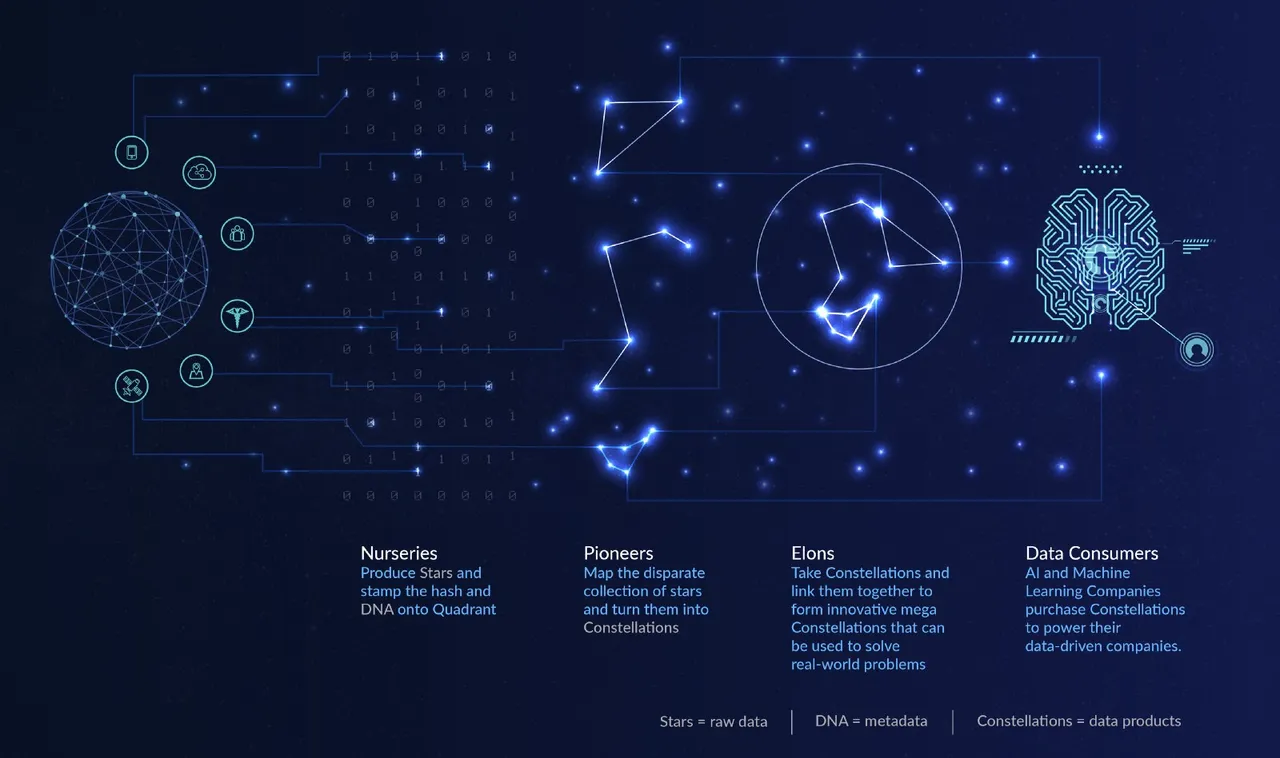Executive summary
Vast amounts of authentic data are needed to power today ’s algorithms, however, the current data economy is fraught with problems. There is an ever-widening gap between those with the resources to collect and store their own data and those that do not. The data these have-nots do have access to is often fragmented and of questionable authenticity—the kind of data that produces poor results when fed to algorithms. Part of the reason why the data lacks authenticity is that the suppliers of it are not properly incentivized. Fair revenue distribution does not exist for both data producers and vendors. Without a healthy and transparent data economy, the increasing demand for authentic data will not be met.
Quadrant aims to solve these problems by providing a blueprint for mapping disparate data sources. It will support proof of data authenticity and provenance via data stamping, the creation of “constellations” (data smart contracts) for disparate data sources, and fair remuneration and incentive sharing. Data consumers can trust the authenticity of the data they purchase, “nurseries” (data producers) are compensated fairly every time their data is used, and “pioneers” (data vendors) have the incentive to create innovative constellations. This new transparent ecosystem ensures that companies get the authentic data they need. where quadrant has major potential for impact is the ability it provides “elons” (the brightest data minds) to find linkages between different constellations and, in turn, create mega constellations that can be used by data consumers to solve real-world problems. This is where quadrant differentiates itself from its competitors.
Quadrant is designed to work with both centralized and decentralized services. The architecture consists of the core quadrant blockchain, clients (data producer, data consumer and anchor), and guardian nodes. Quadrant will operate on a proof of authority consensus mechanism so that it can handle more transactions, operate at a lower gas price, achieve faster transactions, and restrict malicious nodes from entering data into the network. An external proof of work chain will be used as an anchor for security purposes. For the time being, the Ethereum blockchain will be used for anchoring but it can be replaced by any public chain in the future if needed. quadrant will utilize two different currencies for its network: eQuad and quad. Quad, a utility token, is designed to be used solely on the network. It will be used to stamp data, support simple and complex access structures, simple and complex subscription payments, and for staking by elons. EQuad is an erc-20-compliant token that will be sold during the token generation event
(TGE). It may be converted into quad via a gateway when the quadrant main net is launched.
The TGE will have a hard cap of $20,000,000 USD. If the TGE raises over $7,000,000 USD, the
Contributions garnered will be locked initially and made transferrable over the course of 4 years, with 40% becoming available upon the close of the eQuad token sale and the remaining 60% released annually to be applied towards the company's objects at a fixed rate of 15%. This is intended to ensure the long-term success of quadrant while instilling practicality to ensure no over-spending in the initial years. 1,000,000,000 eQuad will be created during the TGE. The tokens will be distributed as follows:
40% to the crowd-sale, 20% to be held by company, 20% to the stakeholders, 10% to the reserve, and 10% to the team.

The problems facing the data economy
There are four major problems facing the data economy: